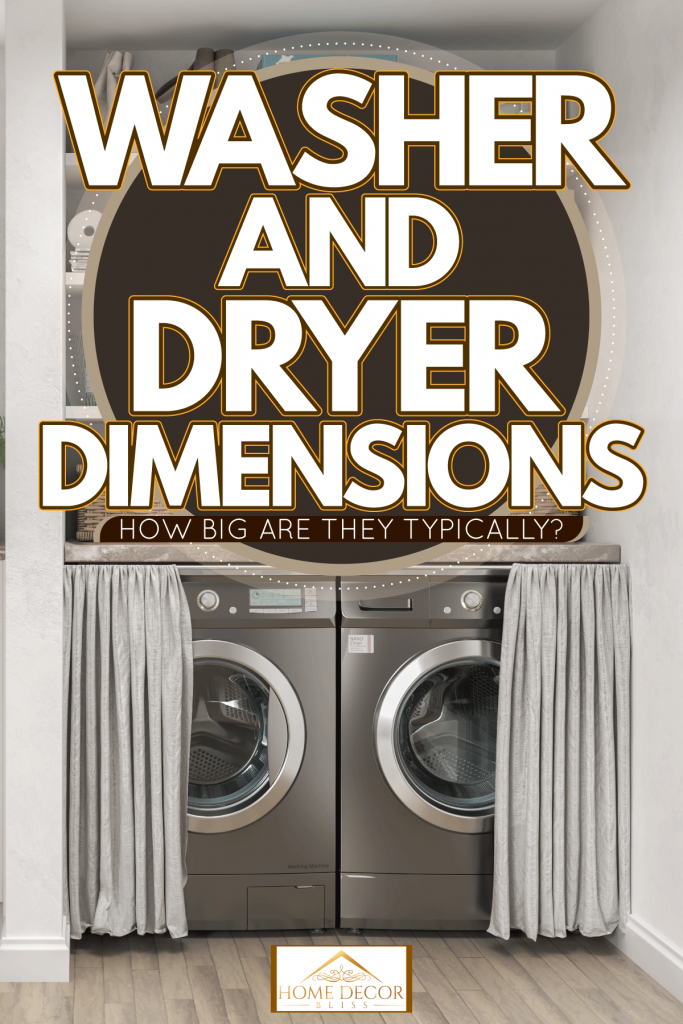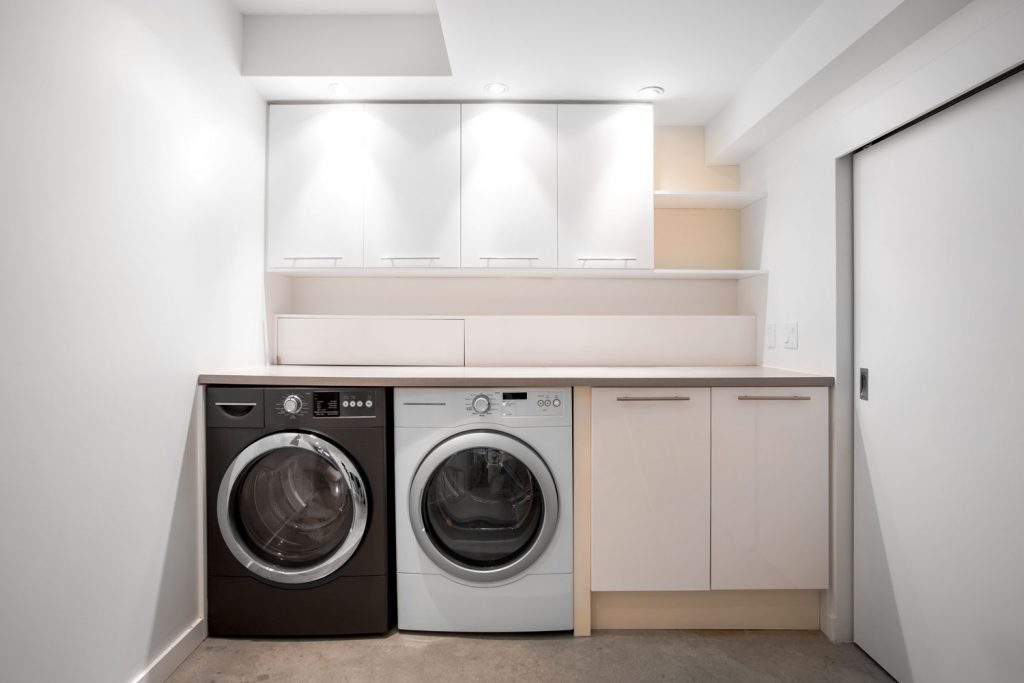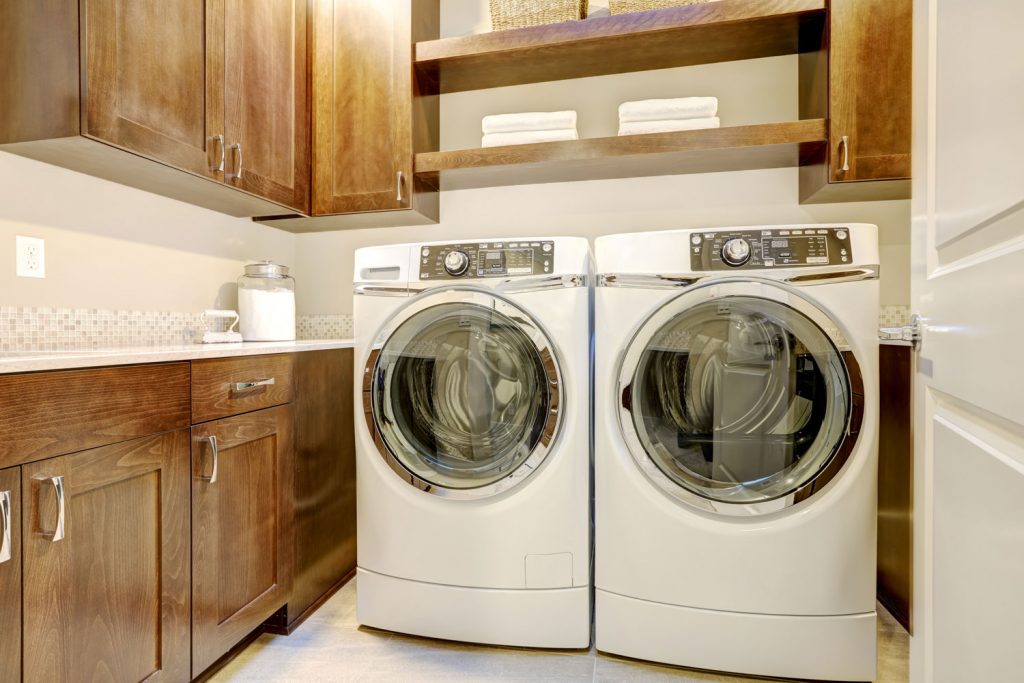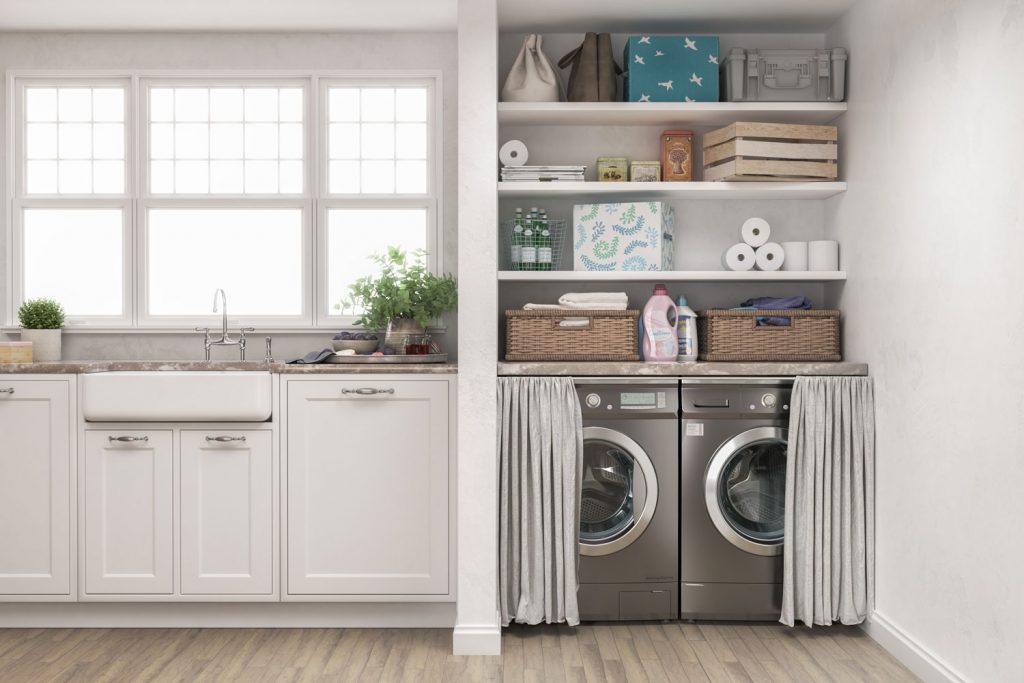If you're in the market for a new washer and dryer, one of the first questions is, "Where will we put it?" Not every home has a clear and dedicated laundry space, and you might not be sure where it can fit in naturally. You need to know just how big are a washer and dryer? We've checked with appliance experts to round up the answers for every common style out there.
When picking a washer, there are both front and top-loading machines. Both types are about 27 inches wide for standard, full-size machines. There are also compact or mega-capacity machines.
Dryers, similarly, tend to be about 27 inches wide - but can be found in compact or mega-capacity options. Width and depth vary between these three sizes. There are also single-unit washers and dryers: while typically 27 inches wide, these also come in compact models.
Keep reading, and we will cover the dimensions for all of these categories. We'll cover what you need to know about stackable options and the differences between the front and top-loading washers. Next, we will explain how much room you need for your machine. Finally, we'll cover what you need to consider before putting your washer and dryer in a laundry room.

How Much Space Do You Need For A Washer And Dryer?
Front-load washers and dryers come in three basic sizes: compact, full-size, or mega-capacity. There are also top-loading washers. While most top-loading washers are full-size machines, some compact and mega-capacity options are available. Finally, there are single-unit washer/dryer combinations.
Compact
The standard size for a compact washer or dryer is 24 inches wide, 34 inches high, and 24 inches deep with the door closed. They're about 42-44 inches deep, measuring with the door open.
We sometimes add affiliate links and content that was curated and created by our team with the help of advanced ai tools to help showcase the best design styles.

They're smaller and easier to fit in a tight space. Of course, this also reduces the capacity. They're about 1.5-2.5 cubic feet. Compare this to a full-size machine, which is 3.0-4.0 cubic feet.
Typically, you only see compact machines as front-load washers. They're often small enough to fit under a countertop.
Full-Size
Full-size washers and dryers have a bigger capacity, letting you wash more clothes in each load. They're also ideal for stacking if you're tight on space, but find compact machines are just too small for your needs.
They are 27 inches wide, 39 inches tall, and 32-34 inches deep with the door closed. With the door open, the depth measures about 54-57 inches.
Mega-Capacity
If you always seem to have an excess of dirty laundry, these may be the machine for you. They're giant-sized appliances that let you tackle huge loads of laundry with no issue.
Mega-capacity washers and dryers don't have quite the same clear industry standards for size. But they average around 28-30 inches wide, 40-42 inches in height, and 32-34 inches deep. With the door open, they're 55-56 inches deep.
Top Load
Typical top-load washers are about 27 inches wide. However, the height and depth can vary between models. They can be 34-43 inches high and 30-35 inches deep.
The capacity of top-load washers is a bit smaller than most front-loading washers. The agitator takes up some of the drum space, reducing the overall room available.

However, you can find top load washers in compact or mega-capacity styles as well. The dimensions are similar to the ones listed for front-loading washers.
Note that all dryers are front loading. Top-loading only applies to washers.
Single-Unit Washer/Dryers
There are single unit options, where the washer and dryer are sold together as one piece. They can not be removed or separated from each other. This can also sometimes be called a unitized washer and dryer.
These machines usually use a top load washer with a front-loading dryer. As for capacity, they fall somewhere between compact and full-size machines. You can expect a capacity of around 2-3 cubic feet.
Single-unit machines are about 27 inches wide, similar to full-size machines. They are about 70-75 inches tall and 27 inches deep.
What About Dryer Dimensions?
You can always find a dryer similar in dimension to the washer you pick. There are washer and dryer sets that pair machines together. As a result, your laundry equipment looks similar and compatible in size and style.
However, you don't need the washer and the dryer to match unless you plan to stack them. As a general rule, the "standard" dryer is 27 inches wide, 41-44 inches in height, and 28-32 inches deep.
Like washers, manufacturers tend to follow similar sizes, but they can still vary. Check the specifications of a machine to make sure it fits in your space.

How Is Dryer Depth Measured?
Dryer depth only covers the depth of the actual machine. It does not include the space that the door takes up when open. If your machine opens in the front, ensure that your space is deep enough to let the door move unobstructed.
The quoted depth also doesn't account for venting and connections in the back of the machine. You need at least 4-6 inches of clearance behind each unit, which should be added to the overall depth.
It is possible to vent some machines on the side if needed. Check with your manufacturer for specifics on your machine. It isn't possible for all units.
Ask the manufacturer how to get a side vent kit for your machine if it can be done. Or, you can enlist the help of an appliance installation professional.
Are All Washers And Dryers The Same Width?
While many machines fit a reasonably similar size profile, there is no industry standard dimension for a washer or dryer. As a result, all washers and dryers are not the same widths. Most machines are 27 inches wide, but not all.
And don't forget that you need to leave at least an inch open on both sides. This helps minimize noise and improve airflow. Add this to the overall width when deciding where to place your washer and dryer.

How Wide Are Stackable Washers And Dryers?
Single-unit or unitized washer/dryer machines are commonly 27 inches wide. These machines are not separate washer and dryer units that stack together. Instead, they are one combined piece that can not be taken apart.
Most separate-but-stackable washers and dryers come in the standard 27-inch width typical of all full-size machines. However, you can find stackable compact machines that are around 24 inches wide. Similarly, you can find mega-capacity washers and dryers capable of stacking. These are generally 28-30 inches wide.
Not all washers and dryers are designed and compatible with stacking. Be sure to follow the manufacturer's recommendations for your models.
Avoid crossing models or brands when stacking. Washers and dryers go together with a specific, compatible machine. Mixing and matching between units can be dangerous.
As another safety note, the dryer must always stack on top. Washers are considerably heavier than dryers. Incorrectly stacking can be a toppling hazard.
Can You Put A Stackable Washer And Dryer In A Closet?
Technically, yes, you can put a stackable washer and dryer in a closet. That is, as long as the closet has three things:
- Adequate wall sockets to plug the machine in.
- Water connection/drain
- Ability to place a dryer vent outside
And of course, in a small closet, you need to be sure your washer and dryer fit. Don't forget to account for venting space. The extra 4-6 inches that you'll require for vent clearance can be the critical difference between a unit that fits in a closet and one that doesn't.

Be cautious when deciding what fits, however. Don't rely just on the official measurements. Keep in mind that a tight fit can make future maintenance problematic. It may also be challenging to install.
If you don't have room to vent, consider a ventless option. These collect water in a reservoir. The water then gets dumped manually, later. In some situations, this may be the only way to have a dryer when venting isn't possible.
In Conclusion

The average full-size washer and dryer are 27 inches wide. This includes both top-loading and front-loading washers. Most stackable dryers are also 27 inches wide.
However, there are compact and mega-capacity options as well. Compact styles are usually about 24 inches wide, while mega-capacity units can be 30 inches wide. Height and depth vary between models and styles.
Always be sure to check the specifications of a machine to know for sure. While many manufacturers use similar sizing, no industry standard dictates the exact size.
If you enjoyed this article, try reading:
